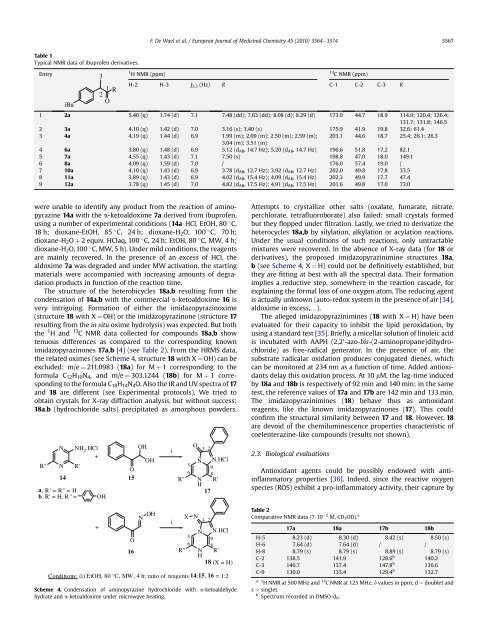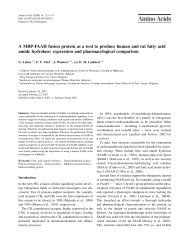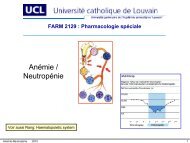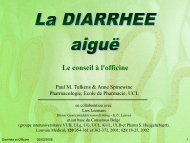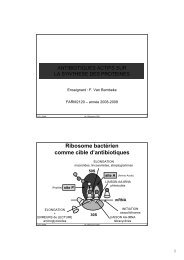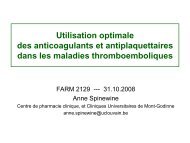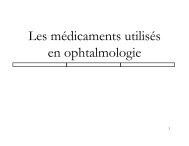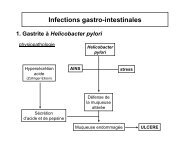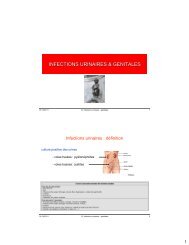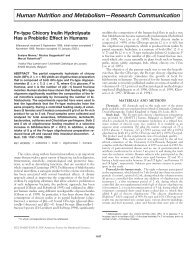Chemistry around imidazopyrazine and ibuprofen - UCL-Bruxelles ...
Chemistry around imidazopyrazine and ibuprofen - UCL-Bruxelles ...
Chemistry around imidazopyrazine and ibuprofen - UCL-Bruxelles ...
You also want an ePaper? Increase the reach of your titles
YUMPU automatically turns print PDFs into web optimized ePapers that Google loves.
Table 1<br />
Typical NMR data of <strong>ibuprofen</strong> derivatives.<br />
Entry<br />
iBu<br />
3<br />
1 R<br />
2<br />
O<br />
1 H NMR (ppm)<br />
were unable to identify any product from the reaction of aminopyrazine<br />
14a with the a-ketoaldoxime 7a derived from <strong>ibuprofen</strong>,<br />
using a number of experimental conditions (14a$HCl, EtOH, 80 C,<br />
18 h; dioxane-EtOH, 85 C, 24 h; dioxane-H2O, 100 C, 70 h;<br />
dioxane-H2O þ 2 equiv. HClaq, 100 C, 24 h; EtOH, 80 C, MW, 4 h;<br />
dioxane-H2O, 100 C, MW, 5 h). Under mild conditions, the reagents<br />
are mainly recovered. In the presence of an excess of HCl, the<br />
aldoxime 7a was degraded <strong>and</strong> under MW activation, the starting<br />
materials were accompanied with increasing amounts of degradation<br />
products in function of the reaction time.<br />
The structure of the heterobicycles 18a,b resulting from the<br />
condensation of 14a,b with the commercial a-ketoaldoxime 16 is<br />
very intriguing. Formation of either the imidazopyrazinoxime<br />
(structure 18 with X ¼ OH) or the imidazopyrazinone (structure 17<br />
resulting from the in situ oxime hydrolysis) was expected. But both<br />
the 1 H <strong>and</strong> 13 C NMR data collected for compounds 18a,b show<br />
tenuous differences as compared to the corresponding known<br />
imidazopyrazinones 17a,b [4] (see Table 2). From the HRMS data,<br />
the related oximes (see Scheme 4, structure 18 with X ¼ OH) can be<br />
excluded: m/e ¼ 211.0983 (18a) for M þ 1 corresponding to the<br />
formula C12H10N4, <strong>and</strong> m/e ¼ 303.1244 (18b) for M þ 1 corresponding<br />
to the formula C18H14N4O. Also the IR <strong>and</strong> UV spectra of 17<br />
<strong>and</strong> 18 are different (see Experimental protocols). We tried to<br />
obtain crystals for X-ray diffraction analysis, but without success:<br />
18a,b (hydrochloride salts) precipitated as amorphous powders.<br />
Attempts to crystallize other salts (oxalate, fumarate, nitrate,<br />
perchlorate, tetrafluoroborate) also failed: small crystals formed<br />
but they flopped under filtration. Lastly, we tried to derivatize the<br />
heterocycles 18a,b by silylation, alkylation or acylation reactions.<br />
Under the usual conditions of such reactions, only untractable<br />
mixtures were recovered. In the absence of X-ray data (for 18 or<br />
derivatives), the proposed imidazopyrazinimine structures 18a,<br />
b (see Scheme 4, X¼ H) could not be definitively established, but<br />
they are fitting at best with all the spectral data. Their formation<br />
implies a reductive step, somewhere in the reaction cascade, for<br />
explaining the formal loss of one oxygen atom. The reducing agent<br />
is actually unknown (auto-redox system in the presence of air [34],<br />
aldoxime in excess,.).<br />
The alleged imidazopyrazinimines (18 with X ¼ H) have been<br />
evaluated for their capacity to inhibit the lipid peroxidation, by<br />
using a st<strong>and</strong>ard test [35]. Briefly, a micellar solution of linoleic acid<br />
is incubated with AAPH (2,2 0 -azo-bis-(2-aminopropane)dihydrochloride)<br />
as free-radical generator. In the presence of air, the<br />
substrate radicalar oxidation produces conjugated dienes, which<br />
can be monitored at 234 nm as a function of time. Added antioxidants<br />
delay this oxidation process. At 10 mM, the lag-time induced<br />
by 18a <strong>and</strong> 18b is respectively of 92 min <strong>and</strong> 140 min; in the same<br />
test, the reference values of 17a <strong>and</strong> 17b are 142 min <strong>and</strong> 133 min.<br />
The imidazopyrazinimines (18) behave thus as antioxidant<br />
reagents, like the known imidazopyrazinones (17). This could<br />
confirm the structural similarity between 17 <strong>and</strong> 18. However, 18<br />
are devoid of the chemiluminescence properties characteristic of<br />
coelenterazine-like compounds (results not shown).<br />
2.3. Biological evaluations<br />
13 C NMR (ppm)<br />
H-2 H-3 J2,3 (Hz) R C-1 C-2 C-3 R<br />
1 2a 5.40 (q) 1.74 (d) 7.1 7.48 (dd); 7.63 (dd); 8.08 (d); 8.29 (d) 173.9 44.7 18.9 114.9; 120.4; 126.4;<br />
131.7; 131.8; 146.5<br />
2 3a 4.10 (q) 1.42 (d) 7.0 3.16 (s); 3.40 (s) 175.9 41.9 19.8 32.6; 61.4<br />
3 4a 4.19 (q) 1.44 (d) 6.9 1.99 (m); 2.09 (m); 2.50 (m); 2.59 (m);<br />
3.04 (m); 3.51 (m)<br />
203.1 44.6 18.7 25.4; 26.1; 26.3<br />
4 6a 3.80 (q) 1.48 (d) 6.9 5.12 (dAB, 14.7 Hz); 5.20 (dAB, 14.7 Hz) 196.6 51.8 17.2 82.1<br />
5 7a 4.55 (q) 1.43 (d) 7.1 7.50 (s) 198.8 47.0 18.0 149.1<br />
6 8a 4.09 (q) 1.59 (d) 7.0 / 176.0 57.4 19.0 /<br />
7 10a 4.10 (q) 1.43 (d) 6.9 3.78 (dAB, 12.7 Hz); 3.92 (dAB, 12.7 Hz) 202.0 49.8 17.8 33.5<br />
8 11a 3.89 (q) 1.43 (d) 6.9 4.02 (dAB, 15.4 Hz); 4.09 (dAB, 15.4 Hz) 202.3 49.9 17.7 47.4<br />
9 12a 3.78 (q) 1.45 (d) 7.0 4.82 (dAB, 17.5 Hz); 4.91 (dAB, 17.5 Hz) 201.6 49.8 17.0 73.0<br />
N<br />
NH2 .HCl<br />
+<br />
R" N R'<br />
O<br />
14 15<br />
a, R'=R"=H<br />
b,R'=H;R"= OH<br />
+<br />
O<br />
16<br />
OH<br />
OH<br />
OH<br />
N<br />
i<br />
i<br />
O<br />
5<br />
6<br />
R"<br />
N<br />
N<br />
H<br />
N.HCl<br />
9<br />
8<br />
R'<br />
17<br />
X<br />
N<br />
3 2<br />
3 2<br />
N N.HCl<br />
5<br />
6<br />
R" N<br />
H<br />
9<br />
8<br />
R'<br />
18 (X = H)<br />
Conditions: (i) EtOH, 80 °C, MW, 4 h; ratio of reagents 14:15, 16 =1:2<br />
Scheme 4. Condensation of aminopyrazine hydrochloride with a-ketoaldehyde<br />
hydrate <strong>and</strong> a-ketoaldoxime under microwave heating.<br />
F. De Wael et al. / European Journal of Medicinal <strong>Chemistry</strong> 45 (2010) 3564e3574 3567<br />
Antioxidant agents could be possibly endowed with antiinflammatory<br />
properties [36]. Indeed, since the reactive oxygen<br />
species (ROS) exhibit a pro-inflammatory activity, their capture by<br />
Table 2<br />
Comparative NMR data (7$10 2 M, CD3OD). a<br />
17a 18a 17b 18b<br />
H-5 8.23 (d) 8.30 (d) 8.42 (s) 8.50 (s)<br />
H-6 7.64 (d) 7.64 (d) / /<br />
H-8 8.79 (s) 8.79 (s) 8.89 (s) 8.79 (s)<br />
C-2 138.5 141.9 128.6 b<br />
140.2<br />
C-3 146.7 137.4 147.8 b<br />
136.6<br />
C-9 130.0 133.4 129.4 b<br />
132.7<br />
a 1 13<br />
H NMR at 500 MHz <strong>and</strong> C NMR at 125 MHz; d values in ppm; d ¼ doublet <strong>and</strong><br />
s ¼ singlet.<br />
b<br />
Spectrum recorded in DMSO-d6.


